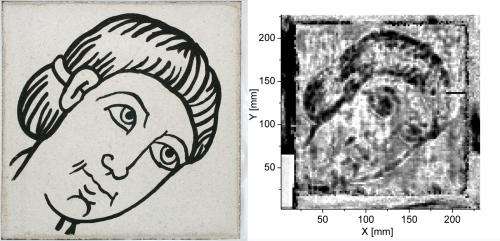Detective work using terahertz radiation

Damaging biocides can be detected on old wooden sculptures, hidden wall paintings can be made visible again and the layered structures of pieces of art analyzed. Using terahertz scanners restorers will soon be able to identify quickly, and completely non-destructively, what is happening with an object of art. Fraunhofer scientists will introduce a new generation of such scanners at the denkmal trade fair, from Nov. 22 - 24 in Leipzig, Germany.
It was a special moment for Michael Panzner of the Fraunhofer Institute for Material and Beam Technology IWS in Dresden, Germany and his partners: in the Dresden Hygiene Museum the scientists were examining a wall picture by Gerhard Richter that had been believed lost long ago. Shortly before leaving the German Democratic Republic the artist had left it behind as a journeyman's project. Then, in the 1960s, it was unceremoniously painted over. However, instead of being interested in the picture, Panzer was far more interested in the new detector which was being used for the first time here. Using it, the scientists gained important information about the layered structure of the wall and the structure of the picture area being examined.
According to Panzer, the special thing about the terahertz (THz) scanner is that "In comparison with traditional processes, such as X-ray scanners, it works without causing any damage whatsoever. In addition, it does not require a special permit, as in the case of harmful X-rays. This is because the scanner only generates a radiated power of less than 1 µW. For comparison: under less than ideal conditions, cell phones emit up to 2 Watts. Furthermore the process, provides concrete data on the structure of the individual layers or of potential hollow areas. In this way the device also indicated in the Hygiene Museum that in one area the plaster on the wall had evidently been repaired - a valuable clue for the restorer."
The scientists used short electromagnetic pulses that penetrate the various materials almost without attenuation, whereby some materials display characteristic absorption lines, which can be used to identify them clearly. In previous tests, however, the system had reached its limits, for example with behind-the-wall paintings on uneven, very structured walls. For this reason the scientists at IWS continued to develop the detector head by modifying the THz optics together with the Fraunhofer Institute for Physical Measurement Techniques IPM. The application spectrum of the scanner was also expanded.
Caution, contaminated art
Currently, many museums cannot present valuable exhibits to the public because they are contaminated with biocides. The reason for this is that in the 1970s, with the best of intentions, antique textiles or wood sculptures were sprayed with pesticides to keep them from being destroyed. Today it is known that these agents are hazardous to health and a number of different measurement and decontamination processes are being tested. IWS, together with further partners, now wants to set up a project with the aim examining the possibilities and limits of the THz technology for organic biocides. "In contrast to the current X-ray fluorescence analysis which works on an element-selective basis, THz scanners recognize substances on the basis of the molecular bonding structure. Organic biocides, in particular, could be differentiated in such a manner," explains Michael Panzner.
To date, such expensive examinations are often only possible in well-equipped laboratories. In the future the tests are to be feasible on-site using a mobile scanner. However, a more research is still required until small, portable devices are available that are suitable for such purposes. Above all, close communication and cooperation with restorers and monument preservationists is required for the continued technological improvement of the THz measurement system. Panzner and his team are also hoping for a lively exchange at the European trade fair for monument preservation, restoration and refurbishment of old buildings, the denkmal, in Leipzig, Germany, where they will be exhibiting the new THz scanner generation in Hall 2, stand H30, from November 22 - 24, 2012.
Provided by Fraunhofer-Gesellschaft
















